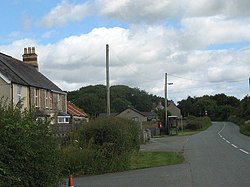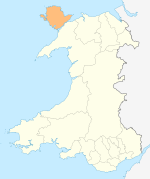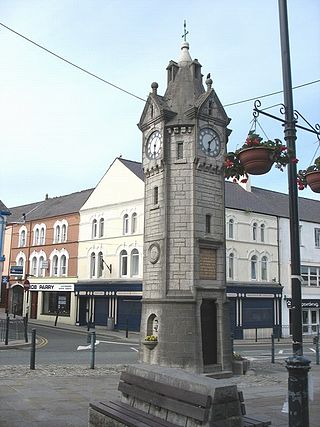
Llangefni is the county town of Anglesey in Wales and contains the principal offices of the Isle of Anglesey County Council. United Kingdom Census 2011 recorded Llangefni's population as 5,116 people, making it the second largest settlement in the county. The community includes the village of Rhosmeirch.

Cemaes is a village on the north coast of Anglesey in Wales, sited on Cemaes Bay, an Area of Outstanding Natural Beauty which is partly owned by the National Trust. It is the most northerly village in Wales. The name Cemaes derives from the Welsh word cemais, meaning "bend or loop in a river, inlet of sea, bay". In 2011 the population of Cemaes in Llanbadrig community was 1,357. The most northerly point in Wales, Ynys Badrig, is nearby.
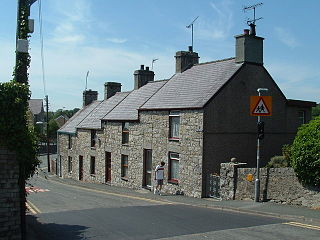
Pentraeth is a village and community on the island of Anglesey, North Wales, at grid reference SH523786. The Royal Mail postcode begins LL75. The community population taken at the 2011 census was 1,178. The village itself having a population of 557.
Dulas Bay is a small bay on the north east coast of Anglesey, north Wales, forming the boundary between Llaneilian and Moelfre communities. The bay is bordered by three beaches.

Llanfairpwllgwyngyll, or Llanfair Pwllgwyngyll, is a large village and local government community on the island of Anglesey, Wales, on the Menai Strait next to the Britannia Bridge and across the strait from Bangor. Both shortened and lengthened (Llanfairpwllgwyngyllgogerychwyrndrobwllllantysiliogogogoch) forms of the placename are used in various contexts.
Nidan was a Welsh priest and, according to some sources, a bishop, in the 6th and 7th centuries. He is now commemorated as a saint. He was the confessor for the monastery headed by St Seiriol at Penmon, and established a church at what is now known as Llanidan, which are both places on the Welsh island of Anglesey. He is the patron saint of two churches in Anglesey: St Nidan's Church, Llanidan, built in the 19th century, and its medieval predecessor, the Old Church of St Nidan, Llanidan. Midmar Old Kirk in Aberdeenshire, Scotland, is also dedicated to him: Nidan is said to have helped to establish Christianity in that area as a companion of St Kentigern. St Nidan's, Llanidan, has a reliquary dating from the 14th or 16th century, which is said to house his relics.

St Cristiolus's Church, Llangristiolus is a medieval church near the village of Llangristiolus, in Anglesey, north Wales. The village, about 1 mile (1.6 km) from the building, takes its name from the church. Reputedly founded by St Cristiolus in 610, the present building dates from the 12th and 13th centuries. Alterations were made in the 16th century, when the large east window in Perpendicular style was added to the chancel – a window which has been described by one guide to the buildings of north Wales as "almost too big to fit" in the wall. Some restoration work took place in the mid-19th century, when further windows were added and the chancel largely rebuilt.
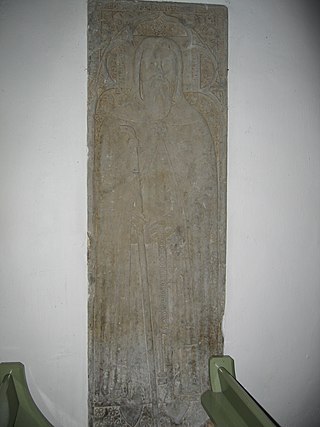
Iestyn was a Welsh hermit and confessor in the 6th or 7th century who is venerated as a saint. He was the founder of two churches, one in Gwynedd and another in Anglesey, both in north Wales.
Saint Peulan was a Welsh holy man in the early part of the 6th century, the son of Paulinus, a saint from south Wales who taught Saint David. A follower of Cybi, a saint associated with the island of Anglesey in north Wales, Peulan is commemorated in the dedication of the church he reportedly founded, St Peulan's Church, Llanbeulan, on Anglesey.
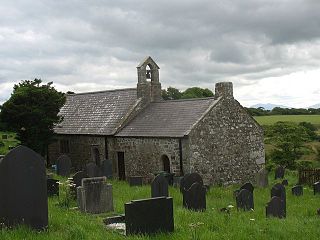
St Cwyllog's Church, Llangwyllog, is a medieval church near Llangwyllog, in Anglesey, north Wales. St Cwyllog founded a church here in the 6th century, although the exact date is unknown. The existence of a church here was recorded in 1254 and parts of the present building may date from around 1200. Other parts are from the 15th century, with an unusual annexe added in the 16th century. The church contains some 18th-century fittings, including a rare Georgian three-decker pulpit and reading desk.
Saint Cwyllog was a Christian holy woman who was active in Anglesey, Wales, in the early 6th century. The daughter, sister and niece of saints, she is said to have founded St Cwyllog's Church, Llangwyllog, in the middle of Anglesey, where a church is still dedicated to her.
Elaeth was a Christian king and poet in Britain in the 6th century who is venerated as a saint. After losing his territory in the north of Britain, he retreated to Anglesey, north Wales, where he lived at a monastery run by St Seiriol at Penmon. Some religious poetry is attributed to him, as is the foundation of St Eleth's Church, Amlwch, also in Anglesey.

St Mary's Church, Bodewryd is a small medieval church in the hamlet of Bodewryd, in Anglesey, north Wales. The date of construction is unknown, but there was a church on this site in 1254 and the earliest feature to which a date can be given is a doorway in a 15th-century style dating to around 1500. When the church was restored in 1867 after being struck by lightning, stained glass with Islamic-influenced patterns was included in the windows, a requirement of Lord Stanley of Alderley, the church's benefactor, who was a convert to Islam.
Tyfrydog was a Christian from north-west Wales in the fifth or sixth century, who was later venerated as a saint. He is said to have established a church in Anglesey, and although no part of the original structure remains, the current church is still dedicated to him. A nearby standing stone is said to be the remains of a man who he punished for stealing a bible from the church.
Caffo was a sixth-century Christian in Anglesey, north Wales, who is venerated as a saint and martyr. The son of a king from northern Britain who took shelter in Anglesey, Caffo was a companion of St Cybi, and is mentioned as carrying a red-hot coal in his clothes to Cybi without his clothes getting burnt. After leaving Cybi, Caffo was killed by shepherds in the south of Anglesey, possibly acting in retaliation for insults Caffo's brother had paid to the local ruler. The area where he died has a village, Llangaffo, named after him, as well as the parish church of St Caffo, Llangaffo.

St Twrog's Church is a small rural church at Bodwrog in Anglesey, North Wales. Built in the late 15th century in a medieval style, some alterations have been made but much of the original structure still remains. It has two 15th-century doorways and some 15th-century windows. The bull's head decoration used on the church denotes a connection with the Bulkeleys of Beaumaris, a prominent north Wales family over several centuries. Set in a remote part of the countryside in the middle of Anglesey, it is dedicated to St Twrog, who was active in the late 5th and early 6th centuries. The church's tithes were paid for at least two hundred years to Jesus College, Oxford, which has historically strong links with Wales, and the college at one point built a house for the priest who served St Twrog's and a neighbouring parish.

St Caian's Church, Tregaian, also known as St Caean's Church, Tregaean, is a small medieval church dating from the 14th century in Anglesey, north Wales. It is dedicated to St Caian, a Christian from the 5th or 6th century about whom little is known. The building contains a late 14th-century east window and a late 15th-century doorway. The churchyard contains the grave of William ap Howel, who died in 1581 at the age of 105, leaving over forty children between the ages of 8 and 89 and over three hundred living descendants.

Llaneilian is a village and community in the Welsh county of Anglesey. It is located in the north east of the island, 2.2 miles (3.5 km) east of Amlwch, 16.5 miles (26.6 km) north west of Menai Bridge and 12.5 miles (20.1 km) north of Llangefni. The community includes the villages and hamlets of Dulas, Llaneilian, Pengorffwysfa, Cerrig Man and Penysarn, Gadfa and Nebo, and at the 2001 census had a population of 1,192, decreasing slightly to 1,186 at the 2011 Census. The parish is crowned by its hill, Mynydd Eilian, a HuMP, popular with walkers and ramblers, and its beach, Traeth Eilian, which is popular with holidaymakers and for watersport activities. At the north easternmost point is Point Lynas,, while Ynys Dulas lies off the North East coast of the island, east of Dulas Bay.
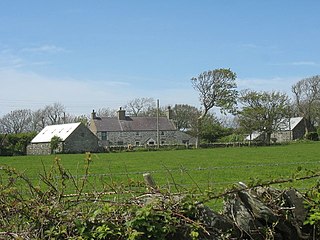
Llanfachraeth is a village and community in the Welsh county of Anglesey. It is located near the west coast of the island, at the head of the Alaw estuary, 6.2 miles (10.0 km) east of Holyhead, 11.7 miles (18.8 km) south west of Amlwch and 11.3 miles (18.2 km) north west of Llangefni. The A5025 road runs through the village. A bus service operates along this road daily, except for Sundays, running between Cemaes, Llanfaethlu, Llanfachraeth and Holyhead. The Wales Coast Path is forced inland here to cross the Afon Alaw. The village has a pub and accommodation is provided by the Holland Hotel.
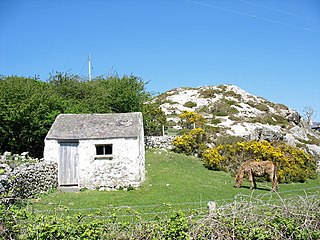
Llanddyfnan is a village and community in Anglesey, Wales, located 3.5 miles (5.6 km) north east of Llangefni, 6.6 miles (10.6 km) north west of Menai Bridge and 7.1 miles (11.4 km) west of Beaumaris.
![]() Welsh pronunciation ) is a small village and ancient parish in the centre of Anglesey, Wales.
Welsh pronunciation ) is a small village and ancient parish in the centre of Anglesey, Wales.